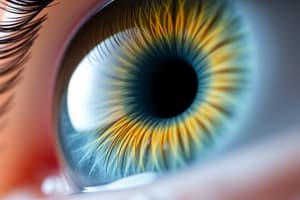Podcast
Questions and Answers
Where are rods primarily located?
Where are rods primarily located?
- Fovea centralis of the retina
- Near the optic nerve
- In the center of the eye
- In the peripheral regions of the retina (correct)
What is the main role of cones in vision?
What is the main role of cones in vision?
- Providing high visual acuity and color vision in bright light (correct)
- Enhancing peripheral vision
- Detecting movement in low-light conditions
- Helping with night vision
What would happen if a person lacked rods in their eyes?
What would happen if a person lacked rods in their eyes?
- Their night vision and ability to see in dim light would be impaired (correct)
- They would struggle to navigate well-lit environments
- They would lose color vision
- Their peripheral vision would improve
Which type of photoreceptor is more suited for detecting shapes and movement in low-light conditions?
Which type of photoreceptor is more suited for detecting shapes and movement in low-light conditions?
If an individual lacked cones in their eyes, what would be a significant consequence?
If an individual lacked cones in their eyes, what would be a significant consequence?
What happens when a person lacks rods in their eyes?
What happens when a person lacks rods in their eyes?
Which photoreceptor would be more effective in allowing an individual to discern shapes and movement in low-light conditions?
Which photoreceptor would be more effective in allowing an individual to discern shapes and movement in low-light conditions?
What is the primary function of cones in vision?
What is the primary function of cones in vision?
Study Notes
Rods and Cones in Vision
- Rods are primarily located in the peripheral retina, responsible for peripheral and night vision.
- The main role of cones in vision is to detect colors and provide central vision.
- If a person lacked rods in their eyes, they would experience night blindness, struggling to see in low-light conditions.
- Rods are more suited for detecting shapes and movement in low-light conditions due to their high sensitivity to low light levels.
- If an individual lacked cones in their eyes, a significant consequence would be the loss of color vision and central visual acuity.
- Without rods, an individual would experience night blindness, struggling to see in low-light conditions.
- Rods would be more effective in allowing an individual to discern shapes and movement in low-light conditions due to their high sensitivity to low light levels.
- The primary function of cones in vision is to detect colors and provide central visual acuity.
Studying That Suits You
Use AI to generate personalized quizzes and flashcards to suit your learning preferences.
Description
Learn about rods, specialized photoreceptors in the eye that are primarily located in the peripheral regions of the retina. Discover their crucial role in night vision and low-light conditions, as well as their ability to detect movement and shapes in dim light.




